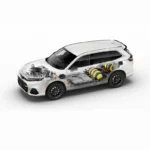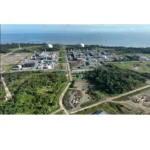Honda Motor announced on Wednesday the commencement of assembly for the CR-V e:FCEV, marking the first time a fuel cell passenger vehicle has been built by an automaker in the United States. The new crossover SUV was unveiled during a media event at Honda’s plant, signifying a significant milestone for the Japanese automaker.
The CR-V e:FCEV, set to launch in the U.S. this year, represents Honda’s latest advancement in fuel cell technology. It boasts an impressive range of 600 kilometers on a quick three-minute hydrogen refill and features a plug-in electric battery capable of 60 kilometers on a single charge for areas without hydrogen filling stations. This dual capability addresses current limitations in the U.S. hydrogen fuel infrastructure, which is mostly concentrated in regions like California.
The fuel cell system for the new CR-V e:FCEV, developed at a joint Honda and General Motors plant in Michigan, is twice as durable as previous models and costs only a third as much to produce. By utilizing the design of an existing Honda SUV, the company has also significantly reduced development costs compared to earlier, purpose-built fuel cell vehicles.
The CR-V e:FCEV will be exported to Japan starting as early as this summer, underscoring Honda’s commitment to both domestic and international markets. This move aligns with Honda’s broader vision of achieving zero emissions for all new vehicles by 2040, which includes both electric and fuel cell vehicles.
The U.S. lacks automakers producing hydrogen-powered passenger vehicles from the fuel cell level up, and the current hydrogen refueling infrastructure is limited. However, the Inflation Reduction Act of 2022 includes tax incentives for fuel cell vehicles, potentially benefiting Honda’s new model.
Honda plans to invest 10 trillion yen ($64 billion) in electric vehicles (EVs) and software development by fiscal 2030. This ambitious investment includes $11 billion dedicated to building EV production facilities and a supply chain in Canada. The CR-V e:FCEV’s production in the U.S. is a critical component of these efforts, aiming to expand Honda’s zero-emission vehicle offerings in North America, including plans to introduce hydrogen-powered trucks.
With the CR-V e:FCEV, Honda is not only pushing the boundaries of fuel cell technology but also reinforcing its commitment to sustainability and innovation in the automotive industry. As the company accelerates its transition to zero-emission vehicles, the introduction of this new model represents a pivotal step towards a greener future.





